20C.70.25 Grass Lawn Neighborhood Regulations.
20C.70.25-010 Purpose.
The Grass Lawn Neighborhood Plan, as described in the Neighborhoods Element of the Comprehensive Plan, includes goals and policies to implement the neighborhood’s vision. Regulations in this chapter of the Redmond Community Development Guide are established to implement the goals and policies described in the Neighborhood Plan. These regulations are designed to accommodate growth in the Grass Lawn Neighborhood that is consistent with the City’s Comprehensive Plan policies while promoting the desired characteristics for the neighborhood. (Ord. 2249; Ord. 1901)
20C.70.25-020 Residential Development: General Provisions.
(1) Purpose. Residential regulations are established to implement the Grass Lawn Neighborhood vision and policies, which are designed to:
(a) Ensure that infill development blends with existing residential areas and that the character of the existing neighborhood is maintained as the area continues to grow.
(b) Promote variety in the size, type, and price of new dwelling units to enable households of different ages, sizes, and incomes to live in the neighborhood and promote diversity within the neighborhood.
(c) Encourage the construction of cottages and multiplex (two to four units) housing types to provide more opportunities for housing choices and provide open spaces within residential developments.
(2) References. In addition to the requirements listed below, the following RCDG sections contain regulations specific to the Grass Lawn Neighborhood:
(a) Cottage Housing Developments: RCDG 20C.30.52.
(b) Multiplex Housing: RCDG 20C.30.70.
(c) Affordable Housing: RCDG 20D.30.10. (Ord. 2249; Ord. 1901)
20C.70.25-030 Multiplex Housing.
(1) Purpose. RCDG 20C.30.70 contains regulations on multiplex housing that apply Citywide until neighborhood plans set the policy on multiplex housing for the neighborhood. The following regulations take the place of RCDG 20C.30.70 for the Grass Lawn Neighborhood for Single-Family Urban zones. All multiplex dwelling units in these zones must meet certain criteria and conditions for location, density, and design to ensure compatibility with the neighborhood. This section contains those conditions.
(2) Applicability. Duplexes, triplexes, and fourplexes are allowed uses on individual lots in locations designated Single-Family Urban in the Grass Lawn Neighborhood.
(3) Density. The allowed number of dwelling units for duplexes, triplexes, and fourplexes shall not exceed the allowed number of detached single-family dwelling units, exclusive of any other bonuses.
(4) Minimum Lot Size and Lot Division. The minimum lot size and lot division provisions of RCDG 20C.30.70-030(1) and (2) shall apply.
(5) Design. Multiplex dwelling units and accessory structures shall have the following design features in addition to those required by RCDG 20C.70.25-040:
(a) Maintain the traditional character and quality of detached single-family dwelling units by using design elements such as single points of entry noticeable from the street, pitched roofs, visible trim or framing around windows, porches, and chimneys.
(b) Be consistent in height, bulk, scale and style with nearby single-family residential uses.
(c) Locate surface parking for multiplex dwelling units in groups of no more than three stalls to appear more consistent with parking for single-family detached dwellings in the area.
(d) Visually separate any parking areas that include more than three stalls from the street or common areas through site planning, landscaping, or natural screening.
(6) Review and Decision Procedures.
(a) Review and decision for duplexes shall occur through the Type I process.
(b) Review and decision for triplexes and fourplexes shall occur through the Type II process, with the following modifications:
(i) In addition to the notification requirements and opportunities to provide public comment as provided in RCDG Title 20F for a Type II permit, applications for triplexes or fourplexes shall also be required to conduct a neighborhood meeting.
(A) The purpose of having a neighborhood meeting is to provide residents who live adjacent and nearby the proposed triplex or fourplex with opportunities to receive information about the project and to provide input regarding the consistency of the proposal with the regulations and on the overall project design before an applicant expends significant time and resources in developing the specific site and development features of the proposal.
(B) The project applicant for triplexes and fourplexes is required to hold a minimum of one neighborhood meeting. The meeting shall be held early in the permit review process.
(C) Notification of the meeting shall be mailed to property owners within 500 feet of the proposal and a sign will be posted on-site, according to the requirements of RCDG 20F.30.35-020(2), Notice of Application Requirements of Type II Review.
(D) The City shall participate in neighborhood meetings. (Ord. 2249; Ord. 1901)
20C.70.25-040 Residential Architectural and Site Design: General Provisions.
(1) Purpose. The purpose of this section is to establish residential design standards for building, site, and landscape design in the Grass Lawn Neighborhood and to guide preparation and review of all applicable development applications. These design standards are intended to assist development applicants in adhering to the desired form of community design in the neighborhood as expressed by goals, policies, and regulations of the Redmond Community Development Guide, which includes the Comprehensive Plan. The purpose of the design guidelines is to:
(a) Provide variety and visual interest in new residential development in a manner that is compatible with the neighborhood character.
(b) Create engaging and active streetscapes through design and vegetation that brings living space toward the street.
(c) Ensure that dwelling units are of a scale and mass that is proportional to their lot size and location.
(d) Provide for the use of landscaping to help provide a transition between new and existing development, to enhance building and site appearance, and to maintain and enhance the environmental quality of the neighborhood.
(e) Encourage public safety for citizens of the neighborhood through building and site design.
(f) Design homes that feature living space as the dominant feature of the street elevation.
(g) Assist applicants and decision-makers reviewing development applications.
(h) Comply with RCDG 20D.40.10-010, Design Standards – Purpose and Intent.
(2) Applicability.
(a) The neighborhood residential design standards apply to applications for new attached and detached single-family development, and expansions to single-family attached and detached dwellings in the Grass Lawn Neighborhood. (See Grass Lawn Neighborhood Map at the end of this section.)
(b) All applications for residential development after the effective date of the 2004 Grass Lawn Neighborhood Plan update which result in a building permit for construction of a new single-family detached or attached dwelling unit or expansion to a single-family detached or attached dwelling unit, unless otherwise exempted by this chapter, shall comply with the intent statements and design criteria as provided in this section and RCDG 20D.40.10-020(2)(d), (e) and (f), Compliance with Design Standards. Dwellings built prior to adoption of these regulations are not considered nonconforming dwellings.
(3) Administration.
(a) Review Process. Building permit applications requiring design review approval shall be processed in accordance with RCDG Title 20F, Administration and Procedures.
(b) Administrative Approval. The Code Administrator shall decide compliance with the design standards. The Design Review Board may become involved in advising the Code Administrator in deciding compliance with the design standards. In no instance shall the Design Review Board act as an appellant body.
(c) Approval Timing. Compliance with the design standards shall be decided prior to issuance of applicable building permits. (Ord. 2249; Ord. 1901)
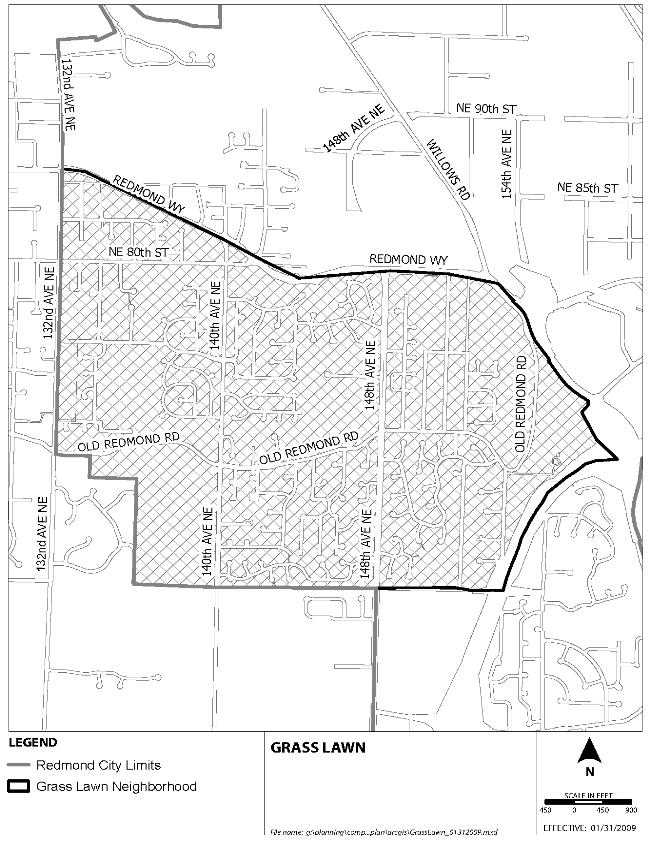
20C.70.25-050 Residential Architectural and Site Design Standards.
(1) Purpose. To establish criteria for design review of new or expanded single-family attached and detached dwelling units in the Grass Lawn Neighborhood per RCDG 20C.70.25-040.
(2) Variety and Visual Interest in Building and Site Design.
(a) Intent.
(i) Character Compatibility. Establish building and site design that promotes variety and visual interest that is compatible with the character of the surrounding neighborhood.
(ii) Variety in Building and Site Design. Prevent the repetitive use of the same combination of building styles, features and site design elements within residential developments and between adjacent dwellings.
(b) Design Criteria.
(i) Variety and Visual Interest. Provide variety and visual interest by using various combinations of building elements, features, and treatments and variation in site design elements in a manner that is compatible with the character of the surrounding neighborhood. Examples of building elements, features and treatments and site design elements that provide variety and visual interest when used in various combinations include, but are not limited to, the following (see Figure 1):
(A) Porches and patios.
(B) Varying roof shapes or gables between adjacent structures.
(C) Windows with visible trim and mullions.
(D) Roof brackets.
(E) Dormers.
(F) Fascia boards.
(G) Bay windows.
(H) Entry enhancement such as a well-detailed door (multi-panel or glass insert), window adjacent to front door, or roof extension.
(I) Trellis.
(J) Modulation.
(K) Chimney (shown on the exterior of the house).
(L) Variation in roof or building colors and materials, such as brick, stone or other masonry as accents.
(M) Variation in housing type and size.
(N) Other building elements, treatments, features, or site designs approved by the Code Administrator that provide variety and visual interest.
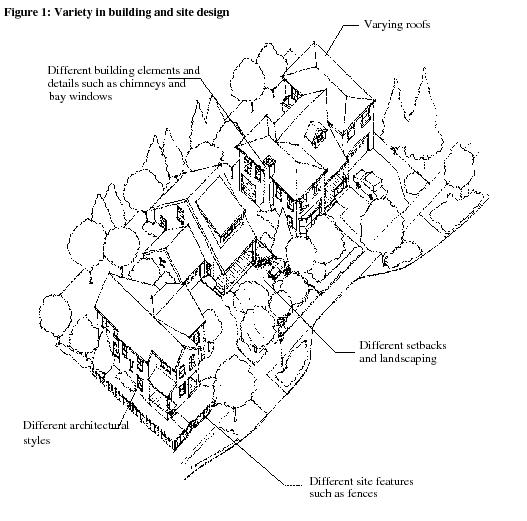
(ii) Variety in Building Design. The same combination of building elements, features and treatments shall not be repeated for more than 20 percent of the total dwelling units in a residential development. Dwellings with the same combination of features and treatments shall not be located adjacent to each other. For example, each dwelling in a five-lot subdivision could include a porch provided building elements such as the details of the porch, roof shape or color, building color or materials, or building accents were varied to achieve visual interest. Short subdivisions less than five lots shall not repeat the same combination. (See Figure 1.)
(iii) Variety in Site Design. Variation in site design shall be achieved through the use of various site planning methods and techniques. Also use various site planning methods and techniques to provide variation in dwellings located on a site perimeter when visible from public streets or park areas. Examples of techniques to provide variety in site design include, but are not limited to:
(A) Variation in lot sizes or orientation.
(B) Variation in setbacks.
(C) Variation in dwelling unit size or type among adjacent or nearby structures along a street.
(D) Variation in type of driveway (shared driveway or not shared).
(E) Alleys. (See Figure 2.)
(F) Other site design features approved by the Code Administrator that provide variety and visual interest.
(iv) Exemptions. The following are exempt from subsection (2) of this section:
(A) Expansions to single-family homes that involve an addition of 50 percent or less of the existing gross floor area are exempt from subsection (2)(b)(i) of this section, Variety and Visual Interest.
(B) Expansions to single-family homes are exempt from subsection (2)(b)(ii) of this section, Variety in Building Design, and subsection (2)(b)(iii) of this section, Variety in Site Design.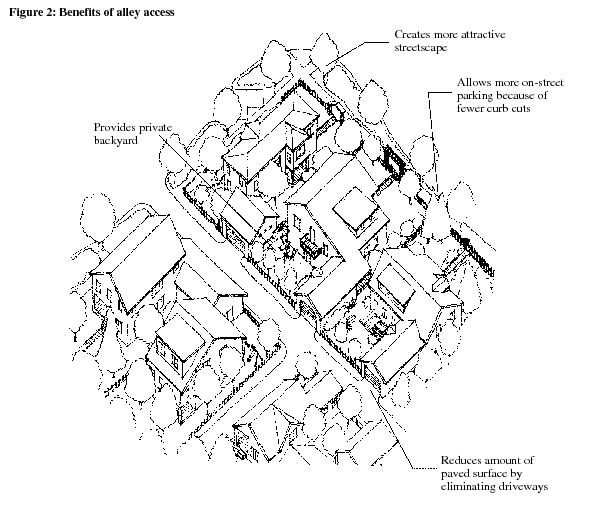
(3) Building Orientation.
(a) Intent. Provide active streetscapes that promote a more walkable and enjoyable neighborhood experience for residents. Require dwelling, site, and streetscape design to incorporate features that bring the primary living area of the dwelling toward the street. (See Figure 3.)
(b) Design Criteria.
(i) For structures located on properties facing an arterial, main living areas may be located toward the rear of the property for noise attenuation, as approved by the Code Administrator.
(ii) Garage Placement.
(A) Except for properties located on arterials, garages shall not be the dominant feature as viewed from the street.
(B) Garages facing the front street shall be set back a minimum of five feet from the street elevation of the dwelling, or otherwise designed and placed in a manner that meets the intent of this section, such as recessing under a second story or a projecting roofline, or other treatment(s). The front street elevation of a side-loaded garage shall have a minimum of one opening (i.e., window or door). Garages that face another direction, i.e., side- and alley-loaded garages, are exempt from the five-foot setback requirement.
(iii) Garage Doors. In order to meet the intent of this section, garage doors facing the front street shall incorporate design features such as, but not limited to, windows, multiple garage doors (for example, one door per parking stall) or other architectural treatments that reduce the apparent mass of the garage door surface(s).
(iv) Transition Area. Provide a minimum 80-square-foot area in the front yard that is oriented toward the front street and includes a porch (minimum dimension eight feet on all sides), patio, deck, garden with entry, walkway with arbor, or other feature(s) that meets the intent of this section.
(v) Alleys. There is a four-foot yard setback for garages that are accessible from an alley. For the purpose of providing visual appeal and interest, when an alley is adjacent to a rear yard, yard landscaping shall extend to the edge of the alley or a landscape strip between the alley and the fence shall be provided.
(vi) Other Methods. The Code Administrator may approve other methods that meet the intent of this section.
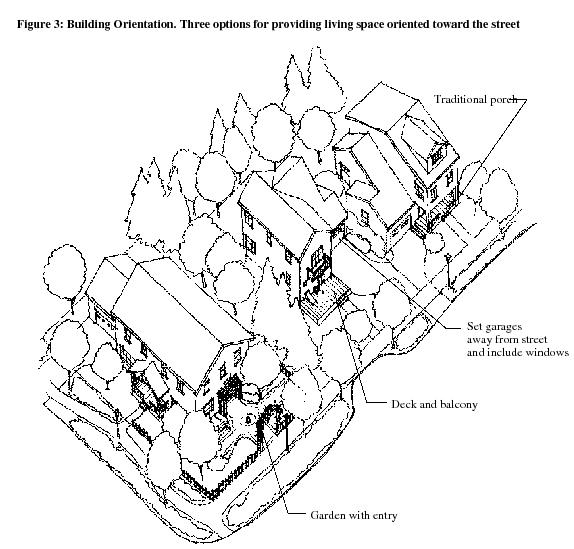
(vii) Exemptions. Expansions to single-family dwelling units are exempt from this section except for the following:
(A) When an expansion is greater than 50 percent of the existing gross floor area of the dwelling unit and the expansion does not include a garage, subsection (3)(b)(iv) of this section, Transition Area, applies.
(B) When an expansion is greater than 50 percent of the existing gross floor area of the dwelling unit and includes a garage, subsection (3) of this section, Building Orientation, applies.
(C) When the expansion consists of a garage only, subsection (3)(b)(ii) of this section, Garage Placement, and subsection (3)(b)(iii) of this section, Garage Doors, apply.
(4) Building Character, Proportionality and Massing.
(a) Intent.
(i) Lot/Structure Proportionality. Lot coverage requirements help to maintain a consistent and compatible land use pattern. The primary land use pattern in the Grass Lawn Neighborhood is dwellings that appear proportional to their lot size. New or expanded dwellings that do not appear oversized for their lot are proportional to their lot size and are compatible with the neighborhood. (See Figure 4.)
(ii) Building Character and Massing. Reduce the apparent size of large infill buildings and expansions to existing single-family homes that add 25 percent or more of the gross floor area to minimize significant impacts on adjacent residents (such as the loss of light and privacy), and give them more visual interest through the use of design techniques. The application of design techniques shall promote compatibility with the surrounding neighborhood while maintaining variety and visual interest in building design and avoiding designs that present a bulky and massive appearance.
(b) Design Criteria.
(i) Maximum Lot Coverage for Structures. The maximum lot coverage for structures shall be as described in RCDG 20C.30.25-140, Site Requirements Chart and Flexibility.
(ii) Lot Coverage for Cottages. Lot coverage for cottages is provided in RCDG 20C.30.52, Cottage Housing Developments.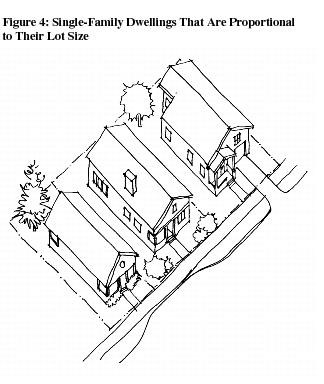
(iii) Modulation and Articulation. Use modulation and articulation in a clear rhythm to reduce the perceived size of large infill residential buildings and expansions to existing single-family dwellings that add 25 percent or more of the gross floor area. The use of these techniques shall be varied between adjacent buildings. (See Figure 5.)
(A) Articulation is the giving of emphasis to architectural elements (like windows, balconies, entries, etc.) that create a complementary pattern or rhythm, dividing the large buildings into smaller identifiable pieces.
(B) Modulation is a measured and proportioned inflection in a building’s face. Together articulation, modulation and their interval create a sense of scale important to residential buildings.
(iv) Consideration of Site Conditions. Buildings should step down or terrace down a hillside for the purpose of fitting into the topography. (See Figure 6.)
(v) Building Separation. Minimum building separation shall be as described in RCDG 20C.30.25-140, Site Requirements Chart and Flexibility. Minimum building separation for cottages is provided in RCDG 20C.30.52, Cottage Housing Developments.
(vi) The Code Administrator may approve other methods that achieve the intent of design criteria (4)(b)(i), Maximum Lot Coverage for Structures, (4)(b)(iii), Modulation and Articulation, and (4)(b)(iv) Consideration of Site Conditions.
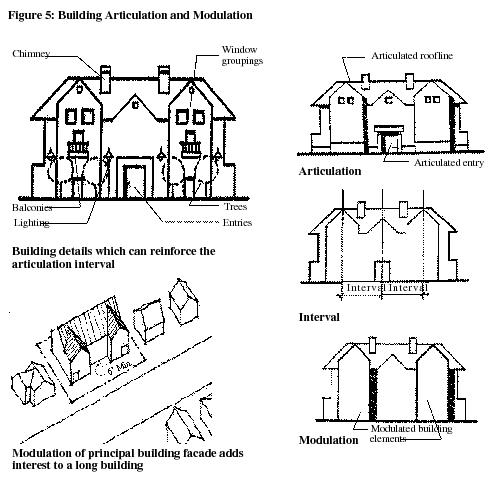
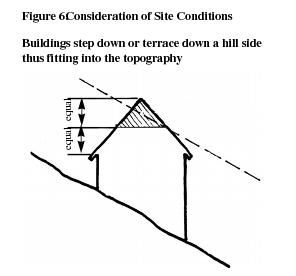
(Ord. 2249; Ord. 1901)


